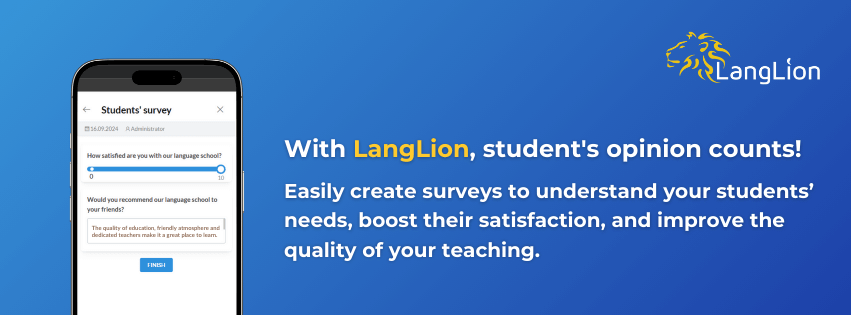
In business, it’s said that if you can’t measure something, you can’t manage it. But what exactly and how should you analyze in a language school? The best way is to get feedback from students.
Surveys are one of the simplest yet most effective tools for collecting opinions. Through them, you can find out what works well and what needs improvement. How do you prepare effective surveys in a language school? What mistakes should you avoid? Here’s a comprehensive guide.
What will you find in the article?
- How to prepare a good survey?
- Surveys in a language school – traditional or online?
- Use surveys wisely – what to keep in mind?
- What to ask students in the survey?
- When to conduct surveys in a language school?
- Summary – surveys in a language school
How to prepare a good survey?
Preparing an effective survey is key to obtaining valuable feedback from students. To ensure the results are reliable and helpful, the survey should be well thought out—both in terms of question content and its form and structure. Let’s begin by exploring step-by-step how to create a survey that provides essential data and aids in improving the language school’s offerings.
Surveys in a language school – traditional or online?
A survey in a language school can take a traditional form—paper sheets with answers to be marked, or it can be internet/online-based. Which one should you choose?
In the case of a large, multi-branch language school, where students use an online Platform or receive information and materials via email, an online survey might be more effective. However, if the school is small and students are less inclined to use new technologies, it might be easier and quicker to prepare an A4 sheet duplicated on a copier.
Pros and cons of traditional and online surveys
Both forms of surveys, traditional and online, have their strengths and weaknesses. What exactly are they?
✅ Advantages of online surveys
- Speed and convenience – students can complete the survey at any place and time.
- Ease of analyzing results – automatic collection and processing of data, generating charts and reports.
- Anonymity – participants are often more willing to share honest opinions.
- Time and resource savings – no need for printing, distributing, and manually tallying results.
❌ Disadvantages of online surveys
- Lower responsiveness – some students may ignore the online survey if they don’t receive additional incentives (e.g., when you send it via email).
- Need for internet access – this can be a problem for some users.
- Lack of physical presence – it’s harder to ask for details or request elaboration on answers.
The survey module in LangLion allows you to easily generate surveys, share them with other system users, and even embed them on, for example, the school’s website.

✅ Advantages of paper surveys
- Higher responsiveness – students are more likely to fill out the survey when they receive it physically right after class.
- Direct contact – the ability to quickly clarify questions and gather more detailed responses.
- No technological barrier – does not require internet access or a computer.
❌ Disadvantages of paper surveys
- Time-consuming – the necessity of manually tallying results and analyzing responses.
- Printing and distribution costs – especially in the case of a large number of students.
- Risk of loss or damage – paper surveys can easily be destroyed or lost.
- Lack of or reduced anonymity – students may feel less comfortable completing surveys in the presence of others.
Use surveys wisely – what to keep in mind?
A survey is an interesting and effective tool, provided we know how to use it. It’s not difficult! 🙂 Below are some principles that will help in creating a good survey.
1. Clearly define what you want to investigate
Don’t ask about general feelings regarding language learning, but for instance, how well-prepared the instructor is for classes, how they explain students’ doubts, and the quality of the learning materials. Think about which areas you want to analyze and tailor the survey to them.
Tip: in the question content, do not use evaluative phrases! (e.g., instead of asking: Does the instructor explain students’ doubts well? pose the question: How do you rate the instructor’s ability to explain students’ doubts?).
2. The survey must be short
A common mistake made by those creating surveys is the desire to ask all possible questions. Students, when faced with several A4 pages containing dozens of questions, will quickly conclude that they don’t have time to fill it out. And they’d be right. The survey regarding conducted classes should take 5-6 minutes.
3. Questions must be precise
Show the prepared questions to someone who hasn’t worked on them. If they start pondering any of them for too long or begin asking what you meant to ask – you need to change them. Respondents should be able to easily and quickly answer the questions, rather than analyze what you wanted to ask.
4. Suggest answers
For most questions, you can propose a set of answers that can easily be translated into numbers. For example:
Do you think the instructor explains the presented material well?
1 – definitely not
2 – probably not
3 – probably yes
4 – definitely yes
Tip: we encourage using a four-point rating scale because people tend to provide the most neutral answers, and based on those, it will be hard for you to draw specific conclusions. Remember to consistently adhere to the introduced scale.
5. Ask an open-ended question
Of course, it’s best to limit most questions to checking answers, e.g., from 1 to 4. But at the end, leave one open-ended question, for example „What else can we do to make lessons more interesting?” Few people will answer an open-ended question, but these can be the most interesting responses.
6. Collect and analyze data
Have you completed surveys? Don’t hide them in your desk drawer; use them. First and foremost, transfer the ratings to a spreadsheet. If instructors have an average class preparation rating around 4–4.5, and one person receives a rating of 3, it means you need to have a serious conversation.
Tip: archive the surveys! If you conduct research at the end of each semester, you can, for example, analyze whether an instructor is improving in a particular area or if there is a downward trend.
What to ask students in the survey?
It’s worth checking how students rate the teachers. First of all, monitor the instructors’ work: whether they are punctual, prepared, and if they speak interestingly and understandably. Ask about the materials you use: both textbooks, movies watched during classes, and e-learning platforms if you use them.
This way, you will find out if they meet the students’ expectations. Also, check if the students are satisfied with the service at the language school, the classrooms, or the school’s location. Well-crafted questions and analyzed responses will help avoid many problems.
Remember! Surveys in a language school only make sense if you analyze the results and implement real changes based on them.
When to conduct surveys in a language school?
The right time to conduct a survey depends on its purpose. Regularly gathering feedback allows you to quickly respond to students’ needs, improve the curriculum, and eliminate any shortcomings.
Here are the best times to conduct a survey.
✔︎ Before the course begins
Before the first class, it’s beneficial to ask students about their expectations, language proficiency level, and preferred learning style. This allows you to tailor the course to their individual needs, ensuring they are more motivated to learn from the start.
✔︎ After the first month of study
An early survey helps identify potential issues before they affect student satisfaction. It’s a good time to check if the pace of the classes is appropriate, if the teaching methods are effective, and if students feel comfortable in the group.
✔︎ After the course ends
The final survey is a crucial tool for evaluating the effectiveness of the course. It can help determine whether students achieved their goals, what they found most valuable, and which elements could be improved.
Tip: The post-course survey is an excellent opportunity to gather recommendations and reviews, which can serve as references in the future. Additionally, you can already propose to your students a course continuation for the next school year!
✔︎ After implementing a new service or program changes
If new courses, a new teaching method, or organizational changes (e.g., new registration system, online payments) are introduced in the school, it’s worth checking how the students evaluate them. This will help quickly eliminate any potential inconveniences and adjust the offer to the real needs of students.
Summary – surveys in a language school
With properly planned surveys, a language school can not only improve the quality of teaching but also build better relationships with students and gain valuable insights for the future. The key to success, however, is not just collecting feedback but, above all, implementing changes based on the students’ responses.
Do you want to gather even more valuable information from your students? Check out our post, NPS: how to survey customer satisfaction with a single indicator!
